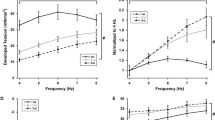Abstract
Isometric force development of electrically paced preparations isolated from the systemic heart of Octopus vulgaris were utilized to examine the regulation of contractility by Ca2+. Increases in extracellular Ca2+, to the physiological level, resulted in enhancement of twitch force. For instance, at 36 beats · min−1 an increase in Ca2+ from 3 to 9 mmol · l−1 resulted in a threefold increase in twitch force development. When steady-state contraction at 12 beats · min−1 was followed by a rest period of either 5 or 10 min, the first contraction always exhibited either an increase in twitch force or stayed unchanged such that post-rest twitch force was about 133% of the last value in the steady-state train. Ryanodine (12.5 μmol · l−1), which is considered to be a specific inhibitor of the Ca2+ storage and release capabilities of the sarcoplasmic reticulum (SR), was applied to further assess Ca2+ handling. Twitch force fell to about 22% of the preteatment level in preparations paced at either 12 or 36 beats · min−1. In all preparations the frequency transition from 12 to 36 beats · min−1 was associated with an increase in resting tension. The␣increase␣was 37 ± 14% prior to ryanodine treatment and was significantly elevated to 127 ± 33% following treatment. When steady-state contraction at 36 beats · min−1 was followed by a rest period of 10 s, the first contraction was not significantly different from the last beat in the train prior to ryanodine; however, with ryanodine treatment, post-rest twitch force development significantly decreased. Twitch force development was regular at pacing rates of up to 300 beats · min−1. Twitch force was maintained up to rates of 84 beats · min−1 but␣decreased thereafter and reached a value of about 10% at 300 beats · min−1. Resting tension increased substantially as frequency was elevated from 12 to 36 beats · min−1 and then gradually increased as frequency was further elevated to 180 beats · min−1. In conclusion, the Octopus ventricle is dependent upon extracellular Ca2+ for contraction. A post-rest potentiation of force development, the negative impact of ryanodine, and the ability to respond regularly at high pacing rates imply a strong reliance on the SR in Ca2+ cycling based on criteria established for vertebrate hearts.
Similar content being viewed by others
Author information
Authors and Affiliations
Additional information
Accepted: 19 January 1997
Rights and permissions
About this article
Cite this article
Gesser, H., Driedzic, W., Rantin, F. et al. Ca2+ regulation of heart contractility in Octopus. J Comp Physiol B 167, 474–480 (1997). https://doi.org/10.1007/s003600050099
Issue Date:
DOI: https://doi.org/10.1007/s003600050099




